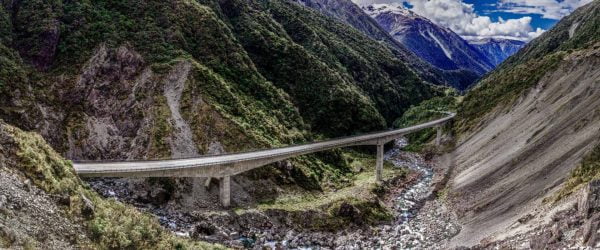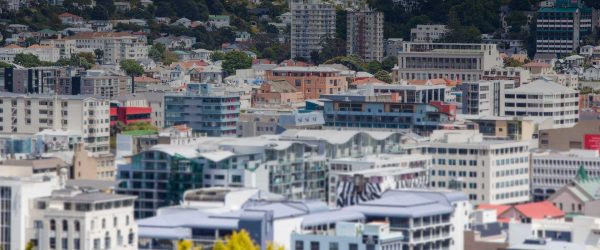Built Environments
Ngā Taiao Waihanga
Vision
The resilience of Aotearoa New Zealand’s horizontal and vertical infrastructure is improved, substantially reducing the financial and human costs of natural hazard events.
Programme description
Natural hazard events cost Aotearoa New Zealand approximately $1.8 billion per year. The built environment, including homes and commercial buildings, and horizontal networks such as electricity, telecommunications and roading, plays a crucial role in our resilience to natural hazards. Following a disruptive event, the performance of infrastructure also determines how rapidly communities can recover.
We aim to improve Aotearoa New Zealand’s resilience to natural hazards such as earthquakes, tsunamis and high impact weather by developing new tools to better understand the performance of our horizontal and vertical infrastructure and how to make them more resistant to damage and easier to repair.
We worked closely with stakeholders and partners including local government, central government agencies, utilities providers, the engineering community, and iwi and hapū. To achieve our aims, we developed:
- Detailed computer models of the impact of natural hazards on infrastructure.
- Proposals for new provisions in infrastructure design and assessment standards.
- New tools to measure the performance of our vertical and horizontal infrastructure and the interaction between its different components.
We used a case study involving a major earthquake scenario in Te Whanganui-a-Tara Wellington to study combined earthquake hazards, their interactions, and their impacts on the city’s vertical and horizontal infrastructure.
Wawata
He pakari ake te manawaroa o ngā tūāhanga huapae me te poutu o Aotearoa, e kaha whakaheke ana i ngā utu ahumoni, tāngata hoki o ngā putanga mōrearea taiao.
Whakaahuatanga papatono
Tata tonu ki te $1.8 piriona i ia tau te utu o nga pānga mōrearea taiao ki Aotearoa. He mahi nui tā te taiao waihanga mō tō tātou manawaroa i ngā mōrearea taiao, tae atu ki ngā whare noho me ngā whare pakihi, ngā whatunga huapae pērā i te hiko, te whitimamao me ngā rori. I muri i tētahi pānga whakatōhenehene, mā te pai o te tūāhanga e tohu i te tere o te whakaoranga o ngā hapori.
E whai ana mātou ki te whakapai ake i te manawaroa o Aotearoa ki ngā mōrearea taiao pērā i ngā rū, ngā tai āniwhaniwha me te huarere taikaha mā te whakawhanake i ngā taputapu hou kia mārama pai ake ki te mahinga o tō tātou hanganga huapae, poutū hoki, ā, me pēhea te whakapakari ake kia kore ai e pakaru, kia māmā ake ai te whakatika.
Kei te mahi tahi mātou me te hunga whaipānga tae atu ki te kāwanatanga ā-rohe, ngā tari kāwanatanga ā-motu, ngā kaiwhakarato tūmatanui, te hapori pūhanga, ngā iwi me ngā hapū. Hei whakatutuki i ō mātou whāinga, kei te whakawhanake mātou i:
- Ngā tauira rorohiko āmiki o te pānga o ngā mōrearea taiao ki te tūāhanga.
- Ngā tono mō ngā whakaritenga hou i roto i te hoahoa tūāhanga me ngā paerewa aromatawai.
- Ngā taputapu hou hei ine i te mahinga o ā tātou tūāhanga poutū me te huapae me te pāhekohekotanga o ōna waehanga.
Kei te whakamahi mātou i tētahi rangahau whakapūaho e pā ana ki tētahi āhuatanga rū nui i Te Whanganui-a-Tara hei rangahau i ngā huinga mōrearea rū, ngā pāhekohekotanga, me ngā pānga ki te tūāhanga poutū me te huapae o te tāonenui.
Questions we’re answering
Research Team
Built Environments
Latest Resource Outputs
Challenge Lifetime Summary
A summary of Resilience Challenge achievements and impacts over ten years of collaborative research
A framework for modelling the probability of flooding under levee breaching
W.Wallace, K. Crawford-Flett, M. Wilson, T. Logan. 2024. A framework for modelling the probability of flooding under levee breaching. Journal of Flood Risk Management. DOI:…
Looking backwards to move forwards: insights for climate change adaptation from historical Māori relocation due to natural hazards in Aotearoa New Zealand
Providing insights from the past to help plan for future adaptation.
Critical infrastructure recovery: Key lessons
Recovery lessons from the 2023 North Island Extreme Weather events, applicable to a range of end-users with various roles in critical infrastructure related recovery activities.
Building resilience through recovery: investment decision-making
Incorporating resilience considerations into disaster recovery and re-establishment of critical infrastructure.
Investigation of representative geotechnical data for the development of a hybrid geotechnical-geospatial liquefaction assessment model
The authors aim to develop a methodology that provides a liquefaction assessment procedure for a vast area that can use easily accessible geospatial data along with subsurface geotechnical data to provide greater detail in the assessment of a site.



